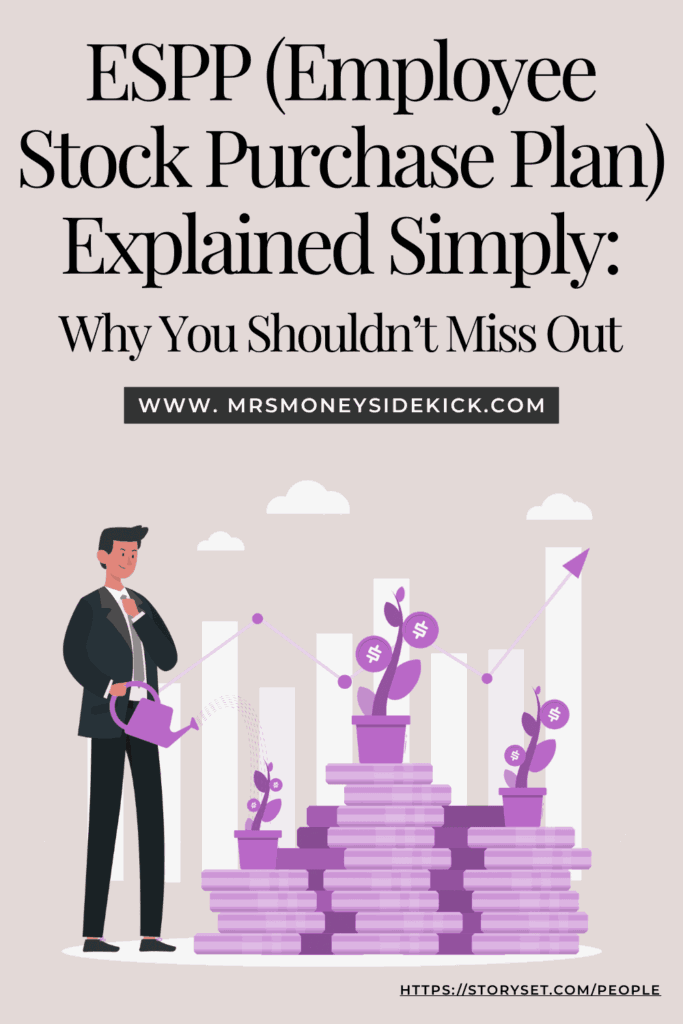ESPP Explained Simply: Why You Shouldn’t Miss Out
If your employer offers an Employee Stock Purchase Plan (ESPP) and you’re not using it, you could be missing out on free money. Don’t worry if you’ve never heard of this benefit. ESPP explained simply guide will show you how it works, how much you can earn, and why it’s one of the smartest financial moves you can make at work.
What Is an ESPP?
An Employee Stock Purchase Plan (ESPP) lets you buy your company’s stock at a discount, usually up to 15% off, using money taken from your paycheck. It’s a benefit many people overlook, but as you’ll see in this ESPP explained simply guide, it can be one of the easiest ways to build wealth, even if you’re a complete beginner.
How Does It Work?
Here’s a step-by-step breakdown of ESPP explained simply in real terms:
- You enroll in the ESPP and choose how much of your paycheck to contribute, often up to 15% of your salary, or a fixed dollar limit.
- Your company deducts a small portion from each paycheck and saves it for a specific time window called the offering period.
- On a specific day at the end of that period, known as the purchase date, your company uses your saved contributions to buy company stock at a discount.
- Once the stock is in your account, you can either:
- Sell it right away to lock in your profit, or
- Hold onto it if you want to stay invested in your company.
Key ESPP Terms to Know
Offering Period: The full timeframe when your payroll deductions are collected. Most companies have either semi-annual or quarterly offering periods.
Purchase Date: The specific day your company uses your saved funds to buy stock at the discount price.
Example (Semi-Annual Schedule):
- Offering Period 1: January 1 – June 30
Purchase Date: June 30 - Offering Period 2: July 1 – December 31
Purchase Date: December 31
If you enroll in January, deductions come from each paycheck through June. Then on June 30, your company buys stock at a discount using your saved contributions.
Your company makes it automatic, and you get the discount without needing to actively trade stocks.

IRS Contribution Limit for 2025
The IRS sets a $25,000 annual limit on ESPP purchases, calculated using the stock’s full market value before applying any discount.
The Power of the Lookback Feature
Many companies offer a lookback provision, which makes your discount even more valuable.
With a lookback, the stock price used to calculate your discount is whichever is lower: the price at the beginning or the end of the offering period.
Lookback Example:
- Stock price on Jan 1 (start): $90
- Stock price on Jun 30 (end): $100
- Company uses the lower price of $90
- With a 15% discount: $90 × 85% = $76.50 per share
Even though the stock is worth $100 on purchase day, you buy it for $76.50, an automatic $23.50 profit per share!
You’ll see how big a difference this makes in the next section, where it becomes real money in your pocket.
Real Earning Example
Let’s say:
- You contribute the max: $25,000/year
- The stock is trading at $100/share
- Your company offers a 15% discount, so you buy shares at $85
- You get ~294 shares ($25,000 ÷ $85)
- You immediately sell those shares for $100 each: 294 × $100 = $29,400
- Your profit: $29,400 – $25,000 = $4,400
You earn an instant 15% profit just by taking part, no investing experience required. This is what ESPP explained simply looks like in real life.
Now Let’s Add the Lookback Provision
If your company includes a lookback, they’ll use the lower stock price between the start and end of the offering period. Suppose the stock price at the start was $90, and it rose to $100 by the end.
- Discounted price = $90 × 85% = $76.50 per share
- You contribute $25,000, so you get ~326 shares ($25,000 ÷ $76.50)
- You sell those shares for $100 each: 326 × $100 = $32,600
- Your profit: $32,600 – $25,000 = $7,600
💰 That’s $3,200 more profit just because of the lookback feature!
This is ESPP explained simply: same effort, even bigger gains, just by understanding your company’s plan.
Understanding Taxes on ESPP Gains
If you sell the stock right away (a common choice to lock in the profit), you report the discount as ordinary income and pay taxes on it just like you do with your paycheck.
Here’s how it works:
- Your taxable income = Market price on purchase date – Purchase price
- This amount is taxed at your regular income tax rate
- Any small difference between the sale price and the market price on purchase day is a short-term capital gain or loss
Tax Example:
- Stock is worth $100, you paid $85
- You made $15 per share in income
- If you bought 100 shares, that’s $1,500 in ordinary income
- If you’re in the 22% federal tax bracket, you’d owe:
- Federal tax: 22% × $1,500 = $330
- State tax (varies): ~9.3% (CA) × $1,500 = $140
- Total tax owed: Around $470
Even after taxes, you’re still coming out ahead. That’s ESPP explained simply, you get a meaningful return with minimal effort.
Tips & Tricks for Beginners

- Start Small: You don’t need to contribute the max right away. Even 1–5% of your paycheck gets you started and helps build the habit.
- Sell Right Away to Lock in Gains: Selling as soon as shares are released avoids market risk and gives you immediate profit.
- Take Advantage of the Lookback: If your company offers it, the lookback feature boosts your discount and makes ESPP deals even better.
- Know Your Dates: Understand your offering periods and purchase dates, they affect when shares are bought and how your taxes work.
- Plan for Taxes: The discount is taxed as ordinary income, so set aside a portion of your profits to cover the bill.
Each of these is part of ESPP explained simply, basic tips to make the most of your workplace benefit.
Even If You’re Not Into Stocks, It’s Worth It
You don’t have to be an investor to benefit. Just participating in an ESPP and selling the shares immediately gives you a predictable, low-risk return that most people can’t get anywhere else. ESPP explained simply means this is for everyone, not just finance pros.
Final Thoughts
ESPPs are one of the easiest ways to grow your money at work. You’re literally buying something for 85 cents that’s worth a dollar (or more, with a lookback). If your company offers this benefit, even a small contribution can lead to meaningful gains, quickly and with minimal effort. Hopefully, you now feel more confident with ESPP explained simply from start to finish.
On your side,
Mrs. Money Sidekick
P.S. Check out these other Money Essentials posts to grow your financial confidence:
- 401(k) Explained Simply:How It Works, Why It Matters, and How Much It Could Grow
- What Is a Roth IRA?
- HSA Account Explained Simply
Let me know if you’d like this version formatted for your blog or turned into a downloadable PDF!
Featured image by People illustrations by Storyset








